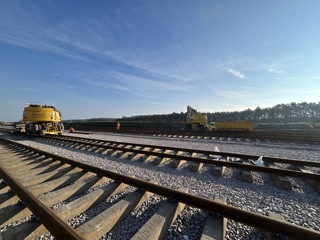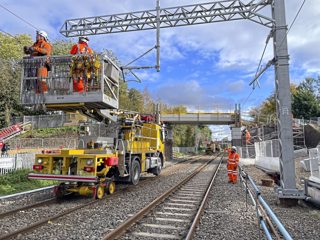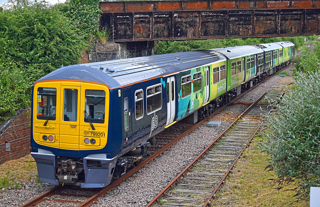View the gallery of the first Network Rail MMT trains.
Working around moving trains is second nature to gangers out on the tracks. But working in a train that’s moving around… that’s going to be a new experience for many of them.
That’s the situation with Network Rail’s new Mobile Maintenance Train (MMT), which is being built by Germany’s Robel. One of its three cars is essentially a mobile shed in which staff can work, protected from the weather and from other trains. But the MMT can also creep slowly along as staff inside work.
The first of NR’s eight MMTs is now at Darlington for extensive tests (usually in clear view of passing trains), as NR and operator Colas Rail get to grips with the opportunities the new fleet offers. The location allows NR to test it in a variety of situations, from the single-track branch to Bishop Auckland to the electrified East Coast Main Line towards York or Berwick. There are also the lines eastwards towards Teesside and Whitby.
Tests started on the Bishop Auckland line on July 27, when the machine deployed between Darlington and North Road stations to complete two welds.
The machine should change the way NR approaches track maintenance. It will certainly change the way gangers work. Currently a maintenance job or minor repair means a gang taking a van to the nearest road access point, and then either carrying their tools and kit to the site or pushing them on a rail trolley. If they forget anything, then it’s a drive back to the depot.
With the MMT, it comes complete with a range of tools, and anything else can be loaded by a day shift before the gang turn up. They board the train and ride to the site in purpose-built accommodation within the traction and supply unit. No more trudging along the cess, or trolley pushing. The MMT can run at up to 60mph, cutting the time taken to reach a repair site.
Once there, work should also be quicker. MMT Supervisor Corey White tells RAIL that the previous weekend his team had changed a concrete sleeper from within the train in one and a half hours. Before the MMT this work could have taken a whole shift.
With the first machine only recently arrived, Network Rail says it’s too early to assess what savings they will bring, but the business case justifying the £5.3 million price tag for each machine was based on savings of £1m per year per machine.
Aboard the MMT during RAIL’s visit is a pallet of track pads. These sit between sleeper and rail, and help track last longer (provided they are changed before they wear out). With onboard machinery to remove and insert the clips that hold the rails to sleepers, changing these pads is made much easier and quicker.
Section Manager Alex Canizo reckons the MMT will change methods, so that NR goes back to routine maintenance in place of renewals. He recalls his early days on track gangs when the ferrules in sleeper chairs would be changed (they ensure chair screws keep a good grip on their chairs), but such techniques have fallen from use, he believes.
Keeping on top of these small jobs prolongs track life and should reduce costs. If the work can be done at night - when no other trains run - then there should be less disruption, and a decisive shift from ‘find and fix’ to ‘predict and prevent’ (which has long been a mantra within NR, and Railtrack before it).
Wet beds could be repaired more quickly. These occur when the trackbed breaks down, and the action of train wheels passing pumps the track up and down, spreading a distinctive slurry mix around the fault. These wet beds can be repaired by digging out the damaged ballast and replacing it with fresh. Of course, these wet beds usually have a cause, such as dipped rail joints, poor quality welds, ballast and drainage problems, loose or missing fastening, missing rail pads or rail surface irregularities.
Keeping on top of these maintenance jobs should prevent the wet beds occurring in the first place and so lift overall track quality, resulting in fewer speed restrictions and fewer major repairs. White’s team has not yet timed wet bed repairs. They had planned for some on the night they changed that first concrete sleeper, but the track they were working on had no wet beds.
Replacing defective rails is within the MMT’s capability, and NR expects such work to take a single shift, rather than the three it says it takes today. The train can carry up to six 45-foot rails (stored under the floor), and has grinding machines on board to dress the railhead after welding. A welder’s life will also be made easier by working in dry conditions and with good lighting. That lighting is a major step forward - it comes with the train, rather than track gangs having to load it all onto a trolley (assuming they’re permitted a trolley).
And it’s not just light the train brings, but also electrical, pneumatic and hydraulic power. The hydraulics, for example, can allow tensioning kit to be used, although Robel had to supply specially designed pressure intensifiers because the train’s hydraulic pressure was lower than that typically used by the tensioners. (They stretch rails used in continuously welded track to allow it to cope with a range of temperatures.)
In addition to the grinder and to the four-track clipping machines that the MMT carries, there are also four Robel track consolidators. Used to lift and pack or tamp track, these hydraulic machines have increased insulation from vibration, so making them easier to use. They are stored along a wall within the MMT’s centre car. Above them, two crane beams run that allow them to be moved easily to the MMT car (that’s the mobile working shed).
The centre car also has hydraulic lifts on each side to allow tools and supplies to be loaded, with the crane allowing materials to be moved along the car. These lifts can only be used in depots, because they are interlocked with the MMT’s traction control. The idea is that the train is self-contained when working out on NR’s lines, and so there’s no need to open these platforms. Indeed, there should be no reason for anyone on the train to leave it.
Having no one working outside the train is vital if NR is to succeed in using the MMT while trains run as normal on adjacent lines, although NR’s trade unions still need to be convinced, with meetings scheduled for October.
But it’s easy to see the difference this change could make. For starters, it could mean that track gangs can repair faults much more quickly than before. In an emergency, for example, the MMT could be sent to a repair site on one track while trains still run on the next track. Currently both lines might have to be closed, but with the MMT adjacent-line trains need not even slow down.
The other major change is that of working as a train in section. This would use NR’s normal signalling arrangements to protect the MMT - it would be just like any other train for which signalling principles state that only one can be in a section of track at any time. Today track staff have to be granted a possession of the line to allow them to work on it undisturbed by trains. (Other work might be done between trains, with the gang moving clear every time a train approaches. This is not suitable for larger jobs and places staff at risk of being hit by trains.)
Combined with keeping the adjacent line open to traffic, working as a train in section reduces the planning needed to effect track repairs (making them quicker), and reduces the risk to track staff.
Until NR is authorised to use the train in this way, it will work in standard T3 possessions booked up to a year in advance. Currently it works nights between Wednesdays and Saturdays, but there’s nothing to stop the machine working more shifts every day or week if NR recruits more crews.
However, it’s not as simple as just parking the train over a fault. The MMT has movable walls that can extend outwards to provide a greater working area. Fully extended outwards by 600mm each, these walls make the train ‘out of gauge’, which means that it could be struck by a train passing on an adjacent line.
Each wall can extend by six steps (each step is 100mm). Extended to Step 2, the MMT remains within the W6A gauge that is the size of a normal freight wagon. In other words, the MMT can still be treated as a normal train for gauge purposes, and it should not be foul of any adjacent tracks. White explains that there’s plenty of measurement work taking place on curves, to assess how far the walls can be opened while remaining safe.
This is an area of potential risk. If the result is a complex directory of wall extension limits depending on the MMT’s location, then there’s a greater chance of mistakes leading to the train being struck.
The traction and supply unit (TSU) of the MMT is DR97501. It is 24.2 metres long and has a cab with a right-hand drive position. There is a combined power-brake handle, as well as independent shunting brake and the usual TPWS panel - the MMT features the Mk 4 version that alerts the driver to the type of TPWS brake application (either overspeed or Signal Passed At Danger).
Much of the train can be controlled from a touchscreen, including starting and stopping engines and cab lighting (which is from LEDs), as well as diagnostics. The desk has a possession switch that limits the train to 40mph.
The TSU has three engines, all of Deutz design. Two 500kW (670hp) V8 engines provide traction power, while a third is a 140kW (188hp) generator that provides ancillary power to the pneumatic, hydraulic and electrical systems. This generator can also provide sufficient traction for the train to operate in creep mode - up to 1.25mph. All four axles of the TSU are powered using hydrostatic transmission. The train has a maximum transit speed of 60mph and is classed as Route Availability 7.
In addition to batteries, the TSU has an ultra-capacitor to store energy. The diesel engines feature ‘AdBlue’ (more commonly found on commercial road vehicles in order to reduce harmful emissions).
Behind the driving cab is a spartan but functional mess area for the track gang. It has a fridge, microwave and seating for 11. There’s also a toilet. The seats are hard with no padding, but the gang will remain here when the MMT is moving to and from site.
A little further along the TSU is a fitters’ workbench used by MMT maintenance teams. It’s followed by a roller shutter door, which is closed when the train is travelling.
The intermediate car (DR97601) is better described as a tool van. Along its 22.5-metre length there is space for up to 20 tonnes of tools, equipment and material. It’s loaded using hydraulic platforms fitted to each side of the car. These platforms are interlocked with the MMT’s traction control, so that they can only be deployed when the train is stationary. They are designed for use in depots.
Beams in the roof of the tool van allow an overhead crane to shift kit either around the van or to and from the mobile maintenance unit that makes up the third car of the train.
Along one wall of the tool van are the track consolidators, rail grinder and clip machines. Along the other is space for stillages containing tools and materials. Along the centre of the car is a well that can contain up to six 45-foot rails.
The mobile maintenance unit car itself is DR97801. As the third and final vehicle of the train it has a driving cab, and is the shortest of the three cars (at 19.0 metres). Steps at both ends of the 16 metre-long working area lead down to the track. Access is prohibited when the train is moving to and from site.
When working, the train is either static or moving at a crawl of no more than 1.25mph. This raises the risk that the train might catch a stationary worker absorbed in his task. To combat this there are light beams at both ends of the working area - if the beam is tripped, then the train stops. In addition, the gang supervisor has an elevated desk from where he can see what his team are doing and warn them when necessary. He can also control the train from this position.
It’s from this position that the sidewalls are controlled. They give a working width of 2m-3.2m, with each wall able to be extended in six steps of 100mm each. Along the side of each wall is a red emergency cable that halts the train if pulled.
The walls have supply points providing electrical (up to 415V AC), hydraulic and pneumatic power. Circular ports are matched to extraction kit to remove welding fumes. In addition, there are vents along the top half of both walls to provide natural light and ventilation - these are controlled from the supervisor’s desk and pneumatically operated.
In the roof are crane beams (similar to those in the tool car) and the two cranes themselves. These are controlled from a remote unit and can work singly or in tandem, with each of the hooks capable of two-tonne loads. The hooks are interlocked with traction power, demanding that they are fully stowed before the train can move.
NR Maintenance Director Neal Lawson welcomed the MMT: “These new trains mean our frontline staff can complete a wide range of maintenance and repairs more quickly and efficiently, reducing the need for costly and disruptive closures of the tracks. They’ll keep our people safe, warm and dry and better able to focus on getting the job done.”
- This feature was published in RAIL 785 (October 14 - 27 2015)
- View the gallery of the first Network Rail MMT trains.

















Login to comment
Comments
No comments have been made yet.